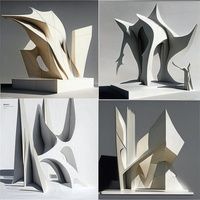Скульптура
Купить антиквариат Скульптура. Приобрести предметы антиквариата на art-picture.ru
Скульптура

Скульптура (лат. sculpture, от sculpo – вырезаю, высекаю), ваяние, пластика – вид изобразительного искусства, произведения которого имеют объемно-пространственную форму, трехмерны и осязаемы. Этот вид искусства возник в древности. Первые резные статуэтки относятся еще к каменному веку. В Древнем Египте статуи служили украшением сооружений, мастера изображали богов, царей, мифологических существ. Особого расцвета это искусство достигло в Древней Греции, где ваятели создавали фигуры богов, правителей, героев мифов и общественных деятелей.
На Руси скульптуру называли ваянием. Этот вид искусства ведет историю с языческих времен, от деревянных идолов. После принятия христианства в городах стали строить храмы, их стены украшали рельефами с растительным или геометрическим орнаментом. В XVIII веке начала развиваться светская скульптура. Зодчие возводили дворцы, фасады которых обильно декорировали статуями. Скульптура подразделяется на круглую, свободно размещающуюся в пространстве, и рельеф, в котором объемные изображения располагаются на плоскости.
Скульптура может быть разделена на виды – станковую, монументальную, монументально-декоративную скульптуру, мелкую пластику. В скульптуре воспроизводится реальный мир, но основным объектом изображения является человек, через внешний облик которого передается его внутренний мир, характер, психологическое состояние, а также человеческое тело, передача движения (голова, бюст, торс, статуя, скульптурная группа). Изображения животного мира составляют анималистический жанр скульптуры.
Выразительность скульптуры достигается с помощью построения основных планов, световых плоскостей, объемов, масс, ритмических соотношений. Большое значение имеют четкость и цельность силуэта. Фактурная обработка поверхности и детали дополняют выразительность пластического решения скульптурного образа. Материалами скульптуры являются камень (мрамор, известняк, песчаник, гранит и др.), дерево, кость, металл (бронза, медь, железо и др.), глина и обожженная глина (керамика – терракота, майолика, фаянс, фарфор и др.), гипс.
Сложная и многоэтапная технология скульптуры сопряжена с большим физическим трудом. Используются различные технические методы – лепка, высекание, резьба, литье, чеканка, ковка, сварка, применяются разнообразные материалы – камень, металл, дерево, глина, гипс, керамика, стекло, пластилин, воск, синтетические полимерные составы. Помимо авторской работы художника (лепка, резьба, обработка твердых материалов) важную роль в скульптуре играет вспомогательный труд мастеров-ремесленников (рубка камня, формовка, отливка, чеканка и др.).
Один из самых древних видов искусства. Различные формы скульптуры существовали у всех народов мира издавна: женские фигуры и рельефы неолита (Венера из Савиньяно (Модена), 10–8 тыс. до н.э.). Развитые формы скульптуры известны у народов Древнего Востока (Царица Нефертити, 14 в. до н.э., Берлин Государственные музеи; рельефы из дворца Ашшурнасирапала II в Нимруде, 883–859 до н.э., Лондон, Британский музей), Древней Америки. Важным этапом истории скульптуры является античность, идеалами которой были создание образа гармонически развитого человека (Мирон, Фидий, Поликлет, Пракситель, Скопас).